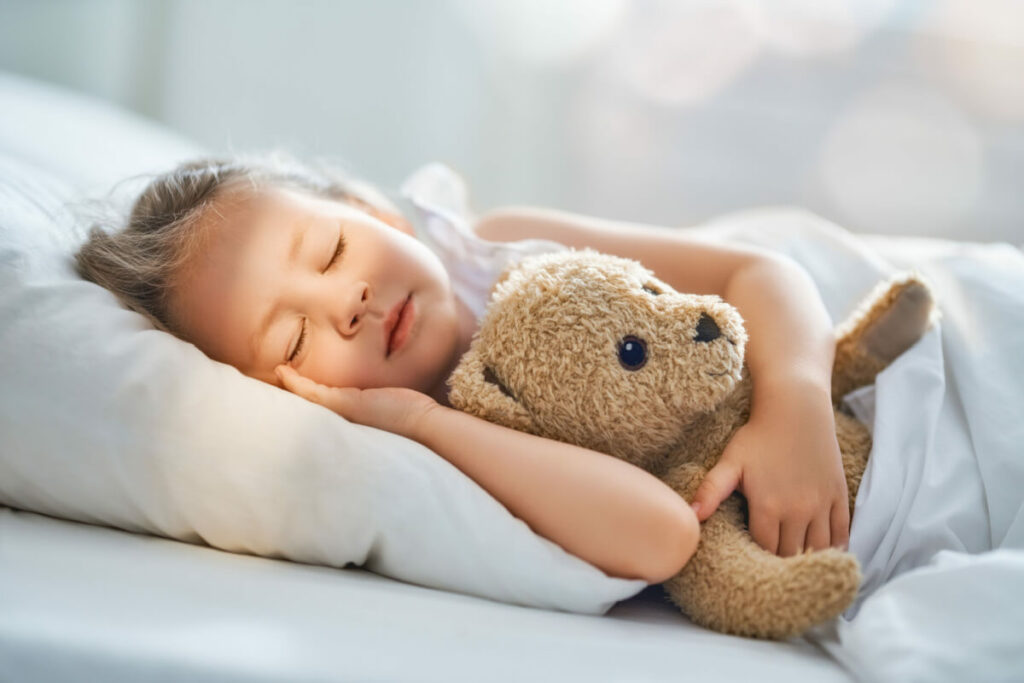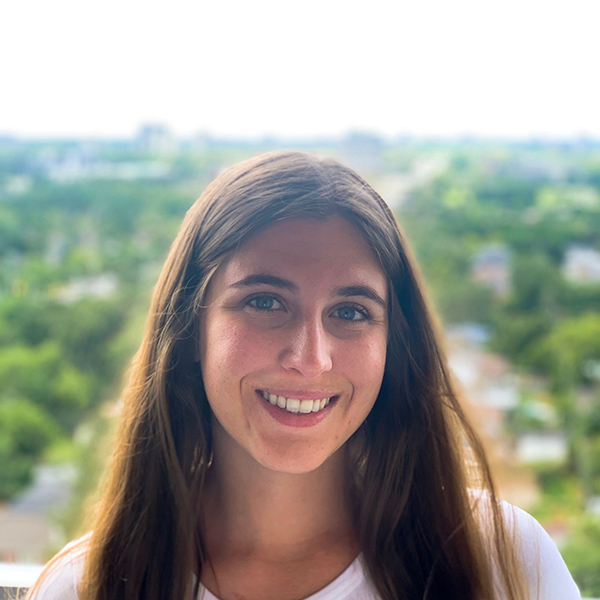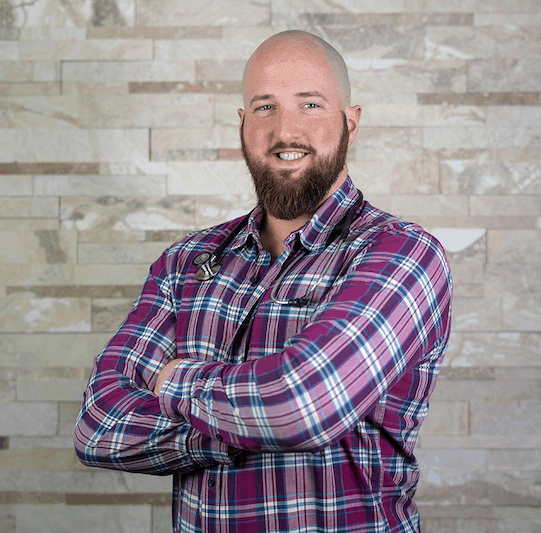Insomnia is a commonly known sleep disorder among adults; however, it also affects 30% of children under the age of five (14) and 20% of children of all ages. (4) A study found that insomnia is often chronic, and 88% of people who struggled with it in their childhood still struggled with it in adulthood. (9) So if your child is suffering from symptoms of insomnia, it’s important not to dismiss it—get to the root of the problem early by implementing a natural sleep aid for kids.
What is insomnia?
Insomnia is the most severe sleep disorder, characterized by a difficulty falling asleep and/or staying asleep, multiple times per week, despite having adequate time to do so. (5)
Insomnia can have serious daytime consequences, affecting attention span, concentration, memory, and mood. (5) In children specifically, insomnia was found to negatively affect a child’s ability to learn, as well as general quality of life for both the child and their family. (14) Insomnia can also increase the risk of other medical disorders, such as depression, high blood pressure, obesity, and diabetes, among others. (3)
Sleep disorders such as insomnia are particularly prevalent in children with attention deficit hyperactivity disorder (ADHD) and autism spectrum disorder (ASD). (7) Girls aged 11 to 12 were also found to have the highest rates of insomnia among children, although a study states that this specifically is thought to be related to hormonal changes and the beginning of puberty. (4)
Routines and behavioral techniques for insomnia
If your child is suffering from symptoms of insomnia, there are numerous natural sleeping remedies that you can try. Cognitive behavioral therapy for insomnia (CBT-I) is a set of practices that act as a behavioral intervention to promote optimal sleep health. CBT-I has been found effective as a natural sleep aid for kids with insomnia. Some of these practices include sleep hygiene, stimulus control, and relaxation techniques. (12)

Sleep hygiene for a good night’s sleep
Follow the tips below for optimal sleep hygiene:
- Set and maintain regular times for your child to go to sleep and wake up, in order to regulate their circadian rhythm (the body’s internal clock).
- Maintain a regular bedtime routine to teach them to wind down for bed.
- Avoid stimulating play or electronics within one hour before bedtime.
- Eliminate napping during the day, so your child feels more tired and ready to sleep at night.
- Ensure a dark, quiet sleep environment to avoid sleep disturbances and promote deep sleep.
- Encourage daily exercise, but avoid exercise close to bedtime.
- Ensure your child falls asleep in their own bed to avoid having to move and risk waking them. This will also help them get comfortable with sleeping in that space.
- For adolescents, eliminate caffeine, nicotine, and alcohol consumption, especially in the evening. (1)(12)
If your child has trouble falling asleep without a parent present, a study recommends gradually removing yourself from their room at bedtime. This can be done by going from laying in bed with them to sitting beside the bed. Next, move from beside the bed to across the room, then from across the room to just outside their door, until eventually they adapt to you being farther away. (12)
Stimulus control
Studies show that stimulus control is another effective natural sleep aid for kids with insomnia. You can implement this by making sure they only use their bed for sleep. This means that your child shouldn’t be playing, reading, or watching TV in their bed. This will help them increase the association of their bed with sleeping and decrease the association of their bed with other activities they enjoy, training their brain to be ready for sleep when they go to bed.
It is recommended that if they can’t fall asleep after 20 minutes, they should get out of bed and engage in a calming, non-rewarding activity for 20 minutes in a different space before returning to bed to attempt sleeping again. (12)
Relaxation techniques
Teaching your child some relaxation techniques is a natural sleeping remedy that can help them learn to calm their active minds and enter into a more restful state. Some helpful relaxation techniques include:
- Deep breathing exercises
- Short meditation practices
- Body scans, where they close their eyes and focus on relaxing each body part, one at a time (12)

Herbal remedies to improve sleep quality
There are numerous herbal remedies that have been shown to aid with sleep duration and sleep quality for adults. Although many of these herbs have not yet been extensively tested as natural sleep aids for kids as well, the herbs listed below have been shown to have very low risk of side effects in general. (2)(6)(13) We recommend speaking with your practitioner first to ensure a herbal remedy is the right fit for your child.
Did you know? While melatonin is a popular sleep remedy among adults, it has not been approved by either the U.S. Food and Drug Administration (FDA) or by Health Canada for child consumption as a sleep aid. (8) The Centers for Disease Control and Prevention (CDC) have also reported an increase in melatonin poisonings, particularly among children. Instead, try one of these other safe alternatives to melatonin for children.
Chamomile
Chamomile has mild sedative effects because it binds to benzodiazepine receptors in the brain, which may be why it tends to be effective as a mild tranquilizer and natural sleeping remedy. Chamomile can be prepared as a herbal tea, or its oil can be used in aromatherapy. (6) Try incorporating a cup of chamomile tea into your child’s bedtime routine for a better night’s sleep.
Lavender
Inhaling lavender oil aromas while asleep was shown to promote quality sleep by improving sleep depth, duration, and wellness, while decreasing sleep disturbances. (11) Try setting up a diffuser in your child’s bedroom, so they can smell the lavender oil while they sleep.
Lavender oil prepared in capsule form for oral use, called Silexan, has been shown to be beneficial for quality and duration of sleep, without causing any sedative effects. It is also beneficial for anxiety, so if your child’s sleep troubles are linked to anxiety, this could be a good natural treatment option for them. (10)
While lavender oil inhalation has been proven safe for children, oral ingestion of lavender in capsules has yet to be tested on children specifically. Make sure to ask your practitioner before using this natural sleeping remedy for your child.
To learn more about the best essential oils for sleep, visit the Fullscript blog.
Valerian
Valerian has been shown to be successful in promoting restful sleep for people with insomnia. Research suggests that it is also not likely to cause any harmful effects in children over the age of seven. However, results are varied and factors like the species of valerian, dosage, and duration all make a difference, so be sure to check with your practitioner first. (15) Valerian also has a slower onset of two to three weeks, so it’s more effective for long-term, continuous use than as an immediate remedy. (16)
The bottom line
If your child has been having difficulty falling and staying asleep at night for an extended period of time, they may be struggling with insomnia. Implementing these natural sleeping remedies, including behavioral techniques and herbal treatments, into their routine could help them sleep well and stay healthy.
- Allen, S. L., Howlett, M. D., Coulombe, J. A., & Corkum, P. V. (2016). ABCs of SLEEPING: A review of the evidence behind pediatric sleep practice recommendations. Sleep Medicine Reviews, 29, 1–14.
- Arslan, I., Aydinoglu, S., & Karan, N. B. (2020). Can lavender oil inhalation help to overcome dental anxiety and pain in children? A randomized clinical trial. European Journal of Pediatrics, 179(6), 985–992.
- Buysse, D. J. (2014). Sleep Health: Can We Define It? Does It Matter? Sleep, 37(1), 9–17.
- Calhoun, S. L., Fernandez-Mendoza, J., Vgontzas, A. N., Liao, D., & Bixler, E. O. (2014). Prevalence of insomnia symptoms in a general population sample of young children and preadolescents: Gender effects. Sleep Medicine, 15(1), 91–95.
- de Zambotti, M., Goldstone, A., Colrain, I. M., & Baker, F. C. (2018). Insomnia disorder in adolescence: Diagnosis, impact, and treatment. Sleep Medicine Reviews, 39, 12–24.
- Gupta, S., Shankar, E., & Srivastava, J. K. (2010). Chamomile: A herbal medicine of the past with a bright future (Review). Molecular Medicine Reports, 3(6).
- Hvolby, A. (2015). Associations of sleep disturbance with ADHD: implications for treatment. ADHD Attention Deficit and Hyperactivity Disorders, 7, 1–18.
- Janjua, I., & Goldman, R. D. (2016). Sleep-related melatonin use in healthy children. Can Fam Physician, 62(4), 315-316.
- Johnson, E. O., Roth, T., Schultz, L., & Breslau, N. (2006). Epidemiology of DSM-IV Insomnia in Adolescence: Lifetime Prevalence, Chronicity, and an Emergent Gender Difference. Pediatrics, 117(2), e247–e256.
- Kasper, S., Gastpar, M., Müller, W. E., Volz, H. P., Möller, H. J., Dienel, A., & Schläfke, S. (2010). Silexan, an orally administered Lavandula oil preparation, is effective in the treatment of ‘subsyndromal’ anxiety disorder: a randomized, double-blind, placebo controlled trial. International Clinical Psychopharmacology, 25(5), 277–287.
- Ko, L. W., Su, C. H., Yang, M. H., Liu, S. Y., & Su, T. P. (2021). A pilot study on essential oil aroma stimulation for enhancing slow-wave EEG in sleeping brain. Scientific Reports, 11(1).
- Lunsford-Avery, J. R., Bidopia, T., Jackson, L., & Sloan, J. S. (2021). Behavioral Treatment of Insomnia and Sleep Disturbances in School-Aged Children and Adolescents. Child and Adolescent Psychiatric Clinics of North America, 30(1), 101–116.
- Müller, S., & Klement, S. (2006). A combination of valerian and lemon balm is effective in the treatment of restlessness and dyssomnia in children. Phytomedicine, 13(6), 383–387.
- Pin Arboledas, G., Soto Insuga, V., Jurado Luque, M. J., Ferrández Gomariz, C., Hidalgo Vicario, I., Lluch Rosello, A., Rodríguez Hernández, P. J., & Madrid, J. A. (2017). Insomnia in children and adolescents. A consensus document. Anales de Pediatría (English Edition), 86(3), 165.e1-165.e11.
- Shinjyo, N., Waddell, G., & Green, J. (2020). Valerian Root in Treating Sleep Problems and Associated Disorders—A Systematic Review and Meta-Analysis. Journal of Evidence-Based Integrative Medicine, 25.
- Wheatley, D. (2005). Medicinal plants for insomnia: a review of their pharmacology, efficacy and tolerability. Journal of Psychopharmacology, 19(4), 414–421.






